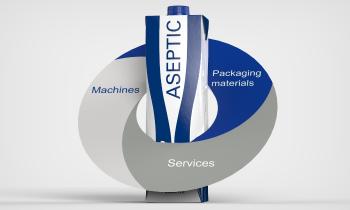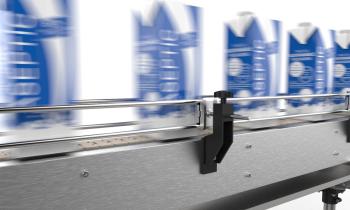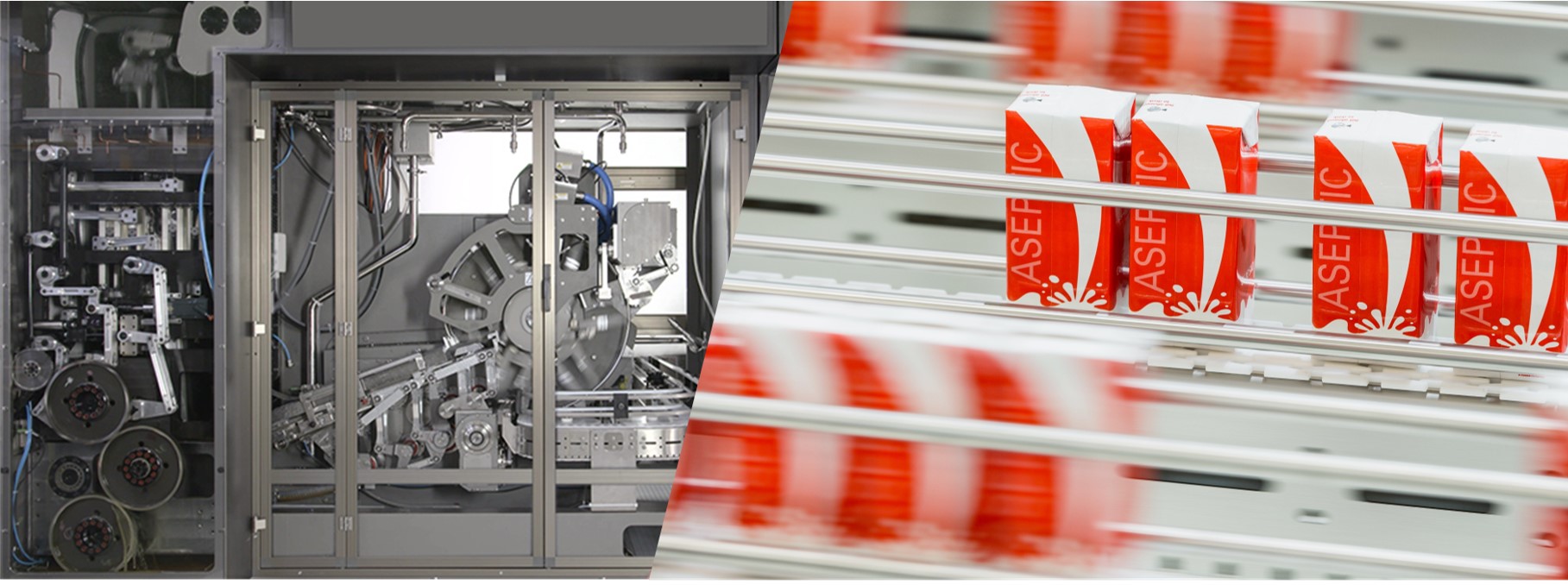Aseptic carton filling machines: the choice between mechanical and mechatronic solutions
Contents of the article
1. MECHANICAL AND MECHATRONIC SOLUTIONS FOR ASEPTIC CARTON PACKAGING
2. ADVANTAGES AND DISADVANTAGES OF THE DIFFERENT TECHNOLOGICAL SOLUTIONS FOR ASEPTIC CARTON PACKAGING
3. CONCLUSIONS ON THE COMPARISON BETWEEN THE TWO DIFFERENT PACKAGING SYSTEMS
The modern industry is demanding few essential characteristics: performance, reliability, and low operating costs. These are indispensable requisites for all technologies used in the various sectors of the market. Moreover,
Companies production also requires switching from one type of packaging to another in the shortest possible time, without the assistance of highly qualified technical personnel.
Let's examine the requirements that filling machines have to meet in terms of aseptic carton packaging.
On one hand, the producers of milk, beverages, and liquid foods require machines that can provide maximum reliability; on the other hand, they require solutions that can deliver increasing levels of flexibility. Examples of this, are machines that can switch from one package shape to another that have the same or a different cross-section.
Mechanical and mechatronic solutions for aseptic carton packaging
Aseptic carton filling machines can be made using mechatronic design solutions (or electronic, with the extensive use of servomotors) or using mechanical solutions (characterised by a mechanical changeover system).
In light of the requirements outlined above, it is perhaps useful to provide an overview of the two solutions so that companies that intend to use aseptic filling machines for packaging products (such as UHT milk, juices, wine, and other liquid foods) in multilayer cartons can make the best choice when purchasing an aseptic filling machine based on their requirements and the characteristics of their company.
It should be clarified that aseptic packaging technology is mainly based on two concepts: packaging integrity and aseptic filling.
The choice between a mechanical or mechatronic solution has no impact on the aseptic process of the multilayer carton filling machine.
Advantages and disadvantages of the different technological solutions for aseptic carton packaging
To understand this more clearly, we will examine the characteristics of the two systems in detail.
The pros and cons of an aseptic filling machine based on a mechatronic drive system
A servomotor drive is intrinsically flexible in as much that it allows you to change the motion laws via software without having to make modifications to the machine. It is therefore fast to implement as the operator only has to select the appropriate configuration from the panel. This is a useful feature if you need to launch a new product on the market because some of the changes are simplified, resulting in time savings and lower costs. Modification to the motion laws using mechatronic technologies can be implemented in all formats used by the filling machine. Moreover, there is no limit to the number of motion laws that can be implemented, and this can be done at any time.
On the other hand, a critical issue related to solutions based on mechatronic drives is that the problems linked to the servomotors are also automation related and therefore require the intervention of a software specialist. It is often impossible for operators and maintenance technicians who are not specialised in the field of automation, to overcome these problems quickly. A minor electronic fault can become a serious problem and result in unscheduled downtime.
In aseptic packaging, the objective, in terms of brick filling precision (volume of edible liquid in ml), is to comply with a tolerance of 1 per thousand. In this respect, the precision that can be achieved by electronic systems has limitations depending on the speed.
This limitation of mechatronic solutions is accentuated when the weight and inertia of the components increase. This is an extremely important aspect for the aseptic carton packaging sector because the integrity of the package depends on the precision of the mechanical settings in specific machine units. Mechatronic solutions typically use belts that may deform during use. This can indirectly cause variations in the mechanical settings: sometimes, this can lead to issues regarding packaging integrity.
Systems based on electronic technologies tend to be more sensitive to power surges in the production facility. This could increase the risk of mechanical failure and should not be underestimated, especially in facilities located in countries in which infrastructure is poor.

The pros and cons of an aseptic filling machine based on a mechanical drive system
Generally speaking, a cam can guarantee absolute precision even at high speed, especially in the case of desmo cam systems that do not permit mechanical play between the components. The repeatability of performance over time is guaranteed and constant, especially if the cam unit is located in a protected and adequately lubricated environment.
Unlike a mechatronic drive system, which in many applications is used in conjunction with belts, cams are less susceptible to problems related to component wear and the possible consequent variations to the mechanical settings. The cam systems are not particularly sensitive to the weights involved, especially at high speeds, as long as the cams are the correct size.
The risk of mechanical failure due to power surges is low because there are fewer electronic components. This obviously has a positive impact in terms of reliability as the movements are mechanically linked together and there is no risk of collision, which would cause costly downtime for the customer.
It is easier, faster, and less expensive to solve technical issues in a mechanical system. In contrast to systems that use servomotors, troubleshooting is more intuitive and does not require the intervention of highly specialised technicians.
In terms of flexibility, from a design point of view, implementing a mechanical solution for changing the format using cams via the operator panel is complex. It would require incredibly advanced mechanical design skills that are rarely available. Although extremely advanced and sophisticated technological design solutions are required, cam mechanisms guarantee greater reliability over time in terms of system robustness and therefore provide better production efficiency.
Contrary to what you might think, mechanical drive systems also allow you to efficiently manage various aspects of flexibility.
First of all, thanks to this solution, it is possible to quickly switch from one package to another having the same cross-section (e.g. change from a square 500 ml package to a square 1000 ml package in just a few minutes, without loss of sterility).
It is possible to switch from one product to another (3D conversion) having a different cross-section, for example from a 200 ml Slim package to a 1000 ml square brick, within a reasonable amount of time, using company personnel (therefore without needing the assistance of the machine manufacturers’ technicians).
Finally, it is possible to use packages having special and personalised shapes on the same machine. Innovative technical solutions mean that the packaging machine is designed to form packages that have not yet been designed i.e. the characteristics (shape and size) of which are not known at the time the machine is purchased. This allows the customer to request a modification to the package format at a later date, according to his marketing requirements.
The mechanical format changeover solution has a higher cost compared to the mechatronic solution because the system needs additional high technological content mechanical units, which are not necessary if a mechatronic system is used. So, basically, you require a cam and an additional mechanical changeover system.
The complexity of the design and the higher costs are justified by the increased reliability, efficiency, and precision.
To summarise: compared to a mechatronic system, a mechanical solution offers greater robustness and significantly higher performance.
Although it is important to underline that these solutions, when applied to the format changeover system, require the use of multiple cam units, in actual production systems there is no need for solutions that require a higher number of format changes. Essentially, the normal production needs of a company can be satisfied using 3 cams.

Conclusions on the comparison between the two different packaging systems
Despite their higher cost and complexity, for aseptic carton packaging where very high levels of performance and reliability are required, mechanical solutions are preferably for packaging systems that allow format changes.
The characteristics of this technological solution, previously discussed in detail, make technical interventions during production runs faster and more streamlined. This guarantees overall advantages in terms of productivity and therefore Total Cost of Ownership (TCO).
IPI has extensive expertise in the implementation of mechanical packaging solutions for many different industries, such as the food and beverage one. The result of this expertise is the FX120 aseptic filling machine: this is the fastest flexible roll-fed aseptic filling machine in the world.
The FX120 combines the strengths of the mechanical transmission systems, a high production capacity and flexibility.
If you would like to receive further information about the FX120 filling machine and other solutions designed by IPI for you, please contact our experts:
 ASEPTIC SOLUTIONS PROVIDER
ASEPTIC SOLUTIONS PROVIDER
 FILLING EQUIPMENT
FILLING EQUIPMENT
